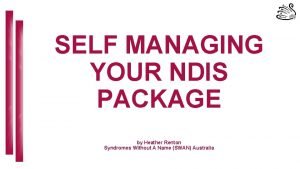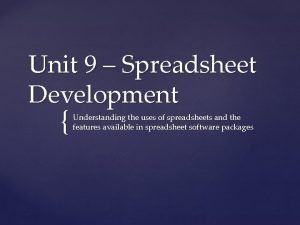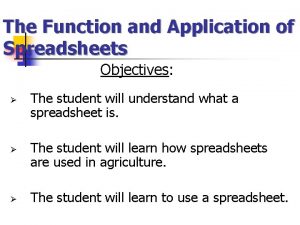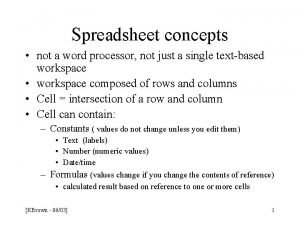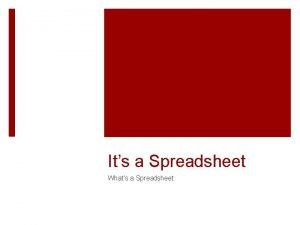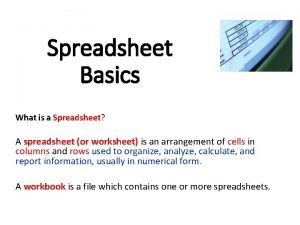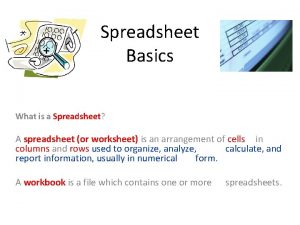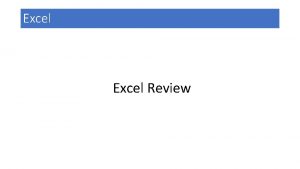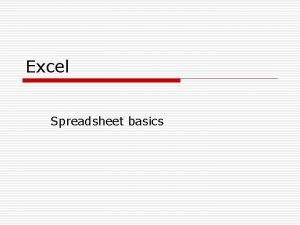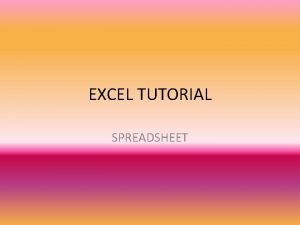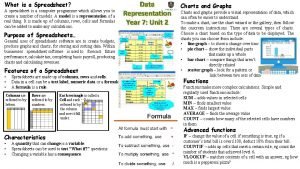Spreadsheet EXCEL Excel works on data that are


















- Slides: 18

Spreadsheet: EXCEL Excel works on data that are arranged by rows and columns, much like Word table. However, it is more powerful and sophisticated than table manipulation. The first so-called killer-application is the spreadsheet software Lotus. Microsoft makes its own i. e. MS EXCEL Excel is a family member of Microsoft Office. During the MS Office installation, Excel comes along. . . Excel is located in Start, Program menu

Excel opening window. . . Title bar Menu bar Standard toolbar Formatting toolbar Address bar Cell Address Row, referenced by number 3 Cell with address B 3 Worksheet Area Status bar Column, referenced by letter B Fill Handle

Data Entry. . . Selected cell appears with heavier boundary. The address of selected cell is shown on the address bar. To select cell, click on the cell. You may use arrow keys to navigate on the cell. To enter data on selected cell, simply type in the data. It appears both on the cell and on the formula bar (beside the address bar). To cancel data entry, press Esc key. To erase data, press Space bar key. To edit a cell entry, select the cell and press F 2 or double click. The entry will appear in the Formula bar. Use arrow keys or mouse to move the insertion point in the formula bar. Then use Backspace or Del keys as the case may be. When finished editing, press Enter Types of Data: Text-letters (A to Z), special characters, and digits (0 to 9). To specify digits to be character, precede it with single quote as in ‘ 910. Numbers-digits (0 to 9) and any of these special characters: +, (, ), $ and %

Copy with Auto. Fill. . . For fast and convenient data entry, Excel has many built-in data to copy. To copy data to another cell, simply drag and drop the Fill Handle of the cell to other cells. When pointer is on fill handle, it appears to be a small cross. If the data to copy happens to be an entry in the Auto. Fill list, the succeeding list of data will be copied. For example enter Jan in cell B 3. When the fill handle of cell B 3 is drag and drop to adjacent cells, the months Feb, Mar, Apr, May and others will be copied. . . Jan

Creating Custom Auto. Fill list. . . Excel has built-in Auto. Fill list. To add your own list. . . Click Custom Lists tab. Open Options dialog box from Tools, Options of Menu bar. NEW LIST is selected. To your own list, click Add button. Enter each item of list making sure to press Enter for next item. . . Custom list could also come from cells…Click this to locate the cells and select the cells. . .

Entering a series. . . A series is set of data with order. To enter a series on adjacent cells, Auto. Fill is not convenient (because it will have to be defined before). A series could be generated automatically by Excel. • Select the first two cells and enter their initial values of the series. • Select the two cells by drag and drop. Selected cells will be highlighted • Drag and drop the fill handle of the selected cells over the range you want to fill. To fill in increasing order, drag right or down; to fill in decreasing order, drag left or up. • Excel will interpret the first and second entries. If there is a difference, or they form part of custom series, the series will be generated. If there is no difference, it will just copy the entries

Working with cells. . . A range is a collection of cells. It could be a single row or single column or combination of them. The range is referenced by its cell at the top left and bottom right. The top left cell is called the anchor of the range. . . Selecting range of cells. . . Drag and drop from the anchor to bottom right cell Click on the row or column heading for entire row or column. For adjacent cells, click on first cell, and while holding Shift key, click on last cell. For non-adjacent cells, click on first cell, and while holding Ctrl key, click on other cells. Anchor cell

Inserting rows and columns. . . To insert rows or columns Click on the row or column heading to select the row or column where a new one will appear. Then, select Insert, Row or Insert, Column as the case may be from Menu bar. This Menu bar option is also available from context pull down menu by clicking the right button while pointing on the selected row or column. Insert, Cells opens dialog box how to move adjacent cells. It works for range of cells.

Formatting Cells. . . The tools in formatting entries of cells and the worksheet itself are the same as in Word for Windows but the formatting applies on data on cells. The technique of applying format is the also the same. . To format a cell or range of cells, Select first the cell(s), and then click the formatting icon from Formatting toolbar. Or open the Format dialog box from Format, Cells of Menu bar. Merge Cells Formatting Toolbar Font Size Bold Italic Underline Increase or decrease decimal Left, Center Right Align Number Formats: Currency Per Cent comma Increase or decrease indent Border Fill and Font Color

Format Cell dialog box. . . Select number category and click on its format Drag and drop this up or down for orientation of text or enter number of degree This has shortcut icon on Formatting toolbar Click on border side or simply click where border will be located This looks familiar! Border has icon on the Formatting toolbar. . .

Operators • Arithmetic (+ (addition), - (subtraction), / (percentage) , * (multiplication), % (division) , ^ (exponentiation)) • Logical (= (equal), >(greater than) , < (less than), >= (greater than or equal to) , <= (less than or equal to), <>(not equal)) • Text (&) • Reference (: (range) , ‘, ’ (union))

Calculations. . . A formula is an expression that performs mathematical operations. • The formula must start with equal sign (=), • followed by combination of cell reference, constant and mathematical operators. To enter a formula: Select cell where the result of calculation will appear Type the equal sign (=) or click on equal sign in Formula bar. Enter the expression. Then press Enter or click anywhere. When you click on the Formula bar, this comes out for help:

Functions are built-in formula that performs calculations on series or range of cells. A function consists of ·Equal sign (=) ·Function name • Argument or parameter enclosed in parenthesis after the function name Equal sign Function Name: SUM Parameter: A 1, B 1 A function can be entered either by typing the equal sign, function name and its arguments directly.

Function Wizard The Function Wizard is a series of dialog boxes that helps you use a function. The wizard is available as icon in Standard toolbar or as menu item in Insert, Function in Menu Bar. Function Wizard Icon: fx

Manipulating data in cells. . . Copying and moving data in cells follows the same technique in Word. Select the cell or range of cells to copy, then drag and drop in desired new location. In moving cells’ contents, the pointer drags at the boundary. To copy without deleting the data from original cell location, hold Ctrl key when dragging and dropping the cell. Copying of cell data or range of cells can also be accomplished using the icons of Copy or Cut and Paste from Standard toolbar. Deleting a cell content or range of cells is simple by selecting the cell or range of cells, and then pressing Del key from keyboard. The menu command for this is found in Edit, Delete from Menu bar. To insert cells or range of cells, select first the cell or range of cells. While holding Shift key, drag and drop the selected cells on desired location. When Ctrl key is pressed, the moved cells overwrite the new cells

Workbook and Worksheet A workbook is equivalent to a document in Word. A workbook may contain one or more worksheets. Data are entered in worksheets and they are initially named as Sheet 1, Sheet 2, Sheet 3 at the lower left corner of the worksheet work area. Worksheet tabs You can add or delete worksheets in a workbook. To add worksheet, add from Insert, Worksheet from Menu bar. To delete worksheet, first select worksheet to delete from its tab. For single worksheet, click the tab. For two or more sheets to select, first click the first sheet, and the next is clicked while pressing Shift or Ctrl key. To delete selected sheet(s), select Edit, Delete Sheet from Menu bar. The opening, closing and saving of workbook are the same with Word. The commands are available at File menu item or as icons in the Standard toolbar.

Moving and Copying Worksheets. . . To move a worksheet to another worksheet in the same workbook, simply drag the worksheet tab to the target worksheet tab and drop. To copy without deleting the original worksheet, do the same with moving of worksheet but this time, hold the Ctrl key. To move worksheet from one workbook to another, open the two workbooks and arrange them as tiles from Windows, Arrange, Tile from Menu bar. Select the worksheet(s) to move by its tab(s), then drag and drop to visible target worksheet tab(s). To change default worksheet names to recognizable labels, double click on the worksheet name and when the tab name is highlighted, type new name. This can be done also by right click on the sheet name to open the context pull down menu, then select Rename option. That would highlight the sheet tab name, and you can type a new name. Notice the other available commands.

Printing Worksheet. . . Printing worksheets is similar to Word’s document printing. The command is at File, Print or its shortcut icon from Standard toolbar or shortcut key of Ctrl+P. Click this to automatically adjust to fit one page. . . Click here to center the worksheet in the page You may also insert header and footer on the page. See how the sheets will be printed. . .
 Antigentest åre
Antigentest åre Ngoại tâm thu thất chùm đôi
Ngoại tâm thu thất chùm đôi Block xoang nhĩ độ 2
Block xoang nhĩ độ 2 Thể thơ truyền thống
Thể thơ truyền thống Thơ thất ngôn tứ tuyệt đường luật
Thơ thất ngôn tứ tuyệt đường luật Chiến lược kinh doanh quốc tế của walmart
Chiến lược kinh doanh quốc tế của walmart Tìm vết của đường thẳng
Tìm vết của đường thẳng Hãy nói thật ít để làm được nhiều
Hãy nói thật ít để làm được nhiều Tôn thất thuyết là ai
Tôn thất thuyết là ai Gây tê cơ vuông thắt lưng
Gây tê cơ vuông thắt lưng Sau thất bại ở hồ điển triệt
Sau thất bại ở hồ điển triệt Heather renton
Heather renton Ms excel merupakan aplikasi
Ms excel merupakan aplikasi Order of operations in excel
Order of operations in excel Safety at streetworks and roadworks
Safety at streetworks and roadworks Spreadsheet development
Spreadsheet development Application of spreadsheet
Application of spreadsheet Qa spreadsheet
Qa spreadsheet Spreadsheet concepts
Spreadsheet concepts











